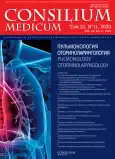Possibilities of therapy for patients with sensorineural hearing loss at the present stage
- Authors: Svistushkin V.M.1, Ordyan A.B.1, Nikiforova G.N.1, Morozova S.V.1, Gergiev V.F.1
-
Affiliations:
- Sechenov First Moscow State Medical University (Sechenov University), Moscow
- Issue: Vol 22, No 11 (2020)
- Pages: 31-33
- Section: Articles
- URL: https://journals.rcsi.science/2075-1753/article/view/95353
- DOI: https://doi.org/10.26442/20751753.2020.11.200370
- ID: 95353
Cite item
Full Text
Abstract
Full Text
##article.viewOnOriginalSite##About the authors
Valeriy M. Svistushkin
Sechenov First Moscow State Medical University (Sechenov University), Moscow
Email: svvm3@yandex.ru
д-р мед. наук, проф., зав. каф. болезней уха, горла и носа Moscow, Russia
Ani B. Ordyan
Sechenov First Moscow State Medical University (Sechenov University), Moscowаспирант каф. болезней уха, горла и носа Moscow, Russia
Galina N. Nikiforova
Sechenov First Moscow State Medical University (Sechenov University), Moscowд-р мед. наук, проф. каф. болезней уха, горла и носа Moscow, Russia
Svetlana V. Morozova
Sechenov First Moscow State Medical University (Sechenov University), Moscowд-р мед. наук, проф., каф. болезней уха, горла и носа Moscow, Russia
Vladimir F. Gergiev
Sechenov First Moscow State Medical University (Sechenov University), Moscowассистент каф. болезней уха, горла и носа Moscow, Russia
References
- Глухота и потеря слуха. Всемирная организация здравоохранения, 2019. https://www.who.int/ru/news-room/fact-sheets/detail/deafness-and-hearing-loss
- Клинические рекомендации. Сенсоневральная тугоухость у взрослых. 2016. Национальная медицинская ассоциация оториноларингологов. http://pro-audiologia.ru/images/pdf/tugouhost-u-vzroslyh.pdf
- Schreiber BE, Agrup C, Haskard DO, Luxon LM. Sudden sensorineural hearing loss. Lancet 2010; 375 (9721): 120311. doi: 10.1016/S0140-6736(09)62071-7
- Парфенов В.А., Антоненко ЛМ Нейросенсорная тугоухость в неврологической практике. Неврология, нейропсихиатрия, психосоматика. 2017; 9 (2): 10-4.
- Kuhn M, Heman-Ackah SE, Shaikh JA, Roehm PC. Sudden Sensorineural Hearing Loss: A Review of Diagnosis, Treatment, and Prognosis. Trends Amplif 2011; 15 (3): 91-105. doi: 10.1177/1084713811408349
- Shirwany NA, Seidman MD, Tang W. Effect of transtympanic injection of steroids on cochlear blood flow, auditory sensitivity, and histology in the guinea pig. Am J Otol 1998; 19 (2): 230-5.
- Cvorovic L, Eric D, Probst R, Hegemann S. Prognostic model for predicting hearing recovery in idiopathic sudden sensorineural hearing loss. Otol Neurotol 2008; 29 (4): 464-9. doi: 10.1097/MAO.0b013e31816fdcb4
- Fitzgerald DC, McGuire JF. Intratympanic steroids for idiopathic sudden sensorineural hearing loss. Ann Otol Rhinol Laryngol 2007; 116 (4): 253-6. doi: 10.1177/000348940711600405
- Parnes LS, Sun AH, Freeman DJ. Corticosteroid pharmacokinetics in the inner ear fluids: an animal study followed by clinical application. Laryngoscope 1999; 109 (7 Pt 2): 1-17. doi: 10.1097/00005537-199907001-00001
- Slattery WH, Fisher LM, Iqbal Z et al. Intratympanic steroid injection for treatment of idiopathic sudden hearing loss. Otolaryngol Head Neck Surg 2005; 133 (2): 251-9. doi: 10.1016/j.otohns.2005.05.015
- Banerjee A, Parnes LS. Intratympanic corticosteroids for sudden idiopathic sensorineural hearing loss. Otol Neurotol 2005; 26 (5): 878-81. doi: 10.1097/01.mao.0000185052.07513.5a
- Bird PA, Begg EJ, Zhang M et al. Intratympanic versus intravenous delivery of methylprednisolone to cochlear perilymph. Otol Neurotol 2007; 28 (8): 1124-30. doi: 10.1097/MAO.0b013e31815aee21
- Косяков С.Я., Атанесян А.Г., Гуненков А.В. Местная терапия острой сенсоневральной тугоухости путем интра-тимпанального введения стероидов. Вестн. оториноларингологии. 2012; 3: 74-8.
- Masoumi E, Dabiri S, Ashtiani MTK et al. Methylprednisolone versus dexamethasone for control of vertigo in patients with definite Meniere’s disease. Iran J Otorhinolaryngol 2017; 29 (95): 341-46.
- Berjis N, Soheilipour S, Musavi A, Hashemi S. Intratympanic dexamethasone injection vs methylprednisolone for the treatment of refractory sudden sensorineural hearing loss. Adv Biomed Res 2016; 5: 111. doi: 10.4103/22779175.184277
- Balough BJ. Intratympanic Dexamethasone for Sudden Sensorineural Hearing Loss After Failure of Systemic Therapy. Yearb Otolaryngol Neck Surg 2008.
- Seggas I, Koltsidopoulos P, Bibas A et al. Intratympanic steroid therapy for sudden hearing loss: A review of the literature. Otol Neurotol 2011; 32 (1): 29-35. doi: 10.1097/mao.0b013e3181f7aba3
- El Sabbagh NG, Sewitch MJ, Bezdjian A, Daniel SJ. Intratympanic dexamethasone in sudden sensorineural hearing loss: A systematic review and meta-analysis. Laryngoscope 2017; 127 (8): 1897-908. doi: 10.1002/lary.26394
- Haynes DS, O'Malley M, Cohen S. Intratympanic dexamethasone for sudden sensorineural hearing loss after failure of systemic therapy. Laryngoscope 2007; 117 (1): 3-15. doi: 10.1097/01.mlg.0000245058.11866.15
- Alexander TH, Harris JP, Nguyen QT, Vorasubin N. Dose effect of intratympanic dexamethasone for idiopathic sudden sensorineural hearing loss: 24 mg/mL is superior to 10 mg/mL. Otol Neurotol 2015; 36 (8): 1321-7. doi: 10.1097/MAO.0000000000000834
- Kiliq R., Safak MA, Oguz H et al. Intratympanic methylprednisolone for sudden sensorineural hearing loss. Otol Neurotol 2007; 28 (3): 312-6. doi: 10.1097/MAO.0b013e31802fba7a
- Bhandari A, Jain S. Early intratympanic methylprednisolone in sudden SNHL: A frequency-wise analysis. Indian J Otolaryngol Head Neck Surg 2019; 71 (3): 390-95. doi: 10.1007/s12070-019-01582-5
- Dai Y, Lu L, Hou J et al. Intratympanic methylprednisolone perfusion as a salvage treatment for profound idiopathic sudden sensorineural hearing loss. J Laryngol Otol 2017; 131 (5): 404-10. doi: 10.1017/S0022215117000548
- Dallan I, De Vito A, Fatto B et al. Intratympanic methylprednisolone in refractory sudden hearing loss: A 27-patient case series with univariate and multivariate analysis. Otol Neurotol 2010; 31 (1): 25-30. doi: 10.1097/MAO.0b013e3181c34f18
- Tarkan 0, Dagkiran M, Surmelioglu 0 et al. Intratympanic methylprednisolone versus dexamethasone for the primary treatment of idiopathic sudden sensorineural hearing loss. J Int Adv Otol 2018; 14 (3): 451-55. doi: 10.5152/iao.2018.4871
- Yang J, Huang L, Shi J et al. The effect of intratympanic dexamethasone or methylprednisolone on treatment of sudden sensorineural hearing loss. Lin Chung Er Bi Yan Hou Tou Jing Wai Ke Za Zhi 2010; 24 (13): 594-7.
- Topf MC, Hsu DW, Adams DR et al. Rate of tympanic membrane perforation after intratympanic steroid injection. Am J Otolaryngol 2017; 38 (1): 21-5. doi: 10.1016/j.amjoto.2016.09.004
- Park SH, Park C, Seo JY et al. How long should patients remain in the supine treatment position after intratympanic dexamethasone injection? Laryngoscope 2014; 124 (12): 2807-10. doi: 10.1002/lary.24872
Supplementary files






